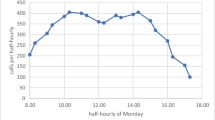Abstract
The multipath fading channel modeling traditionally focuses on physical level dynamics such as signal strength and bit error rate. In this paper we characterize multipath fading channel dynamics at the packet level and analyze the corresponding data queueing performance in various environments. The integration of wireless channel modeling and data queueing analysis provides us a unique way to capture important channel statistics with respect to various wireless network factors such as channel bandwidth, mobile speed and channel coding. The second order channel statistics, i.e. channel power spectrum, is found to play an important role in the modeling of multipath fading channels. The data queueing performance is largely dependent on the interaction between the channel power spectrum and the data arrival power spectrum; whichever has lower frequency power will have more impact on queueing performance. Note that the data arrival power spectrum provides a measure of burstiness and correlation behavior of data packet arrivals. Throughout the paper, we use the Markov chain modeling technique to match the measured important channel statistics for both channel modeling and queueing analysis.
Similar content being viewed by others
References
H. Che and S.Q. Li, Fast algorithms for measurement-based traffic modeling, in: Proc. IEEE INFOCOM '97(April 1997) pp. 53–65.
R.H. Clarke, A statistical theory of mobile-radio reception, Bell Systems Technical Journal 47(1) (July–August 1968) 957–1000.
B.D. Fritchman, A binary channel characterization using partitioned Markov chains, IEEE Transactions on Information Theory 13(2) (April 1967) 221–227.
M.J. Gans, A power-spectral theory of propagation in the mobile radio environment, IEEE Transactions on Vehicular Technology 21(1) (February 1972) 27–38.
K. Ishioka, H. Takanashi and T. Tanaka, Improved throughput characteristics by ARQ with weighted majority decision, in: Proc. IEEE ICUPC '95(November 1995) pp. 467–471.
W.C. Jakes, Jr., Ed., Microwave Mobile Communication(Wiley, New York, 1974).
S.M. Kay, Modern Spectral Estimation: Theory and Application(Prentice-Hall, Englewood Cliffs, NJ, 1988).
Y.H. Kim and S.Q. Li, Timescale of interest in traffic measurement for link bandwidth allocation design, in: Proc. IEEE INFOCOM '96(March 1996) pp. 738–748.
L.A. Kulkarni and S.Q. Li, Measurement-based traffic modeling: capturing important statistics, Journal of Stochastic Model (to appear).
W.C. Lau and S.Q. Li, Traffic distortion and inter-source crosscorrelation in high-speed integrated networks, Computer Networks and ISDN Systems (The International Journal of Computer and Telecommunication Networking) 29(7) (August 1997) 811–830.
S.Q. Li, S. Chong and C. Hwang, Link capacity allocation and network control by filtered input rate in high speed networks, IEEE/ACM Transactions on Networking 3(1) (February 1995) 10–25.
S.Q. Li and C.L. Hwang, Queue response to input correlation functions: Continuous spectral analysis, IEEE/ACM Transactions on Networking 1(6) (December 1993) 678–692.
S.Q. Li and C.L. Hwang, On the convergence of traffic measurement and queueing analysis: A Statistical-MAtch Queueing (SMAQ) Tool, in: Proc. IEEE INFOCOM '95(April 1995) pp. 602–613.
S.Q. Li, S. Park and D. Arifler, SMAQ: A measurement-based tool for traffic modeling and queueing analysis. Part I. Design methodologies and software architecture, IEEE Communications Magazine (August 1998) (to appear).
S.Q. Li, S. Park and D. Arifler, SMAQ: A measurement-based tool for traffic modeling and queueing analysis. Part II. Network applications, IEEE Communications Magazine (August 1998) (to appear).
S.Q. Li and J.D. Pruneski, The linearity of low frequency traffic flow: an intrinsic I/O property in queueing system, IEEE/ACM Transactions on Networking 5(3) (July 1997) 429–443.
T.S. Rappaport, Wireless Communications Principles and Practice(Prentice-Hall, Englewood Cliffs, NJ, 1996).
H.D. Sheng and S.Q. Li, Spectral analysis of packet loss rate at a statistical multiplexer for multimedia services, IEEE/ACM Transactions on Networking 2(1) (February 1994) 53–65.
B. Sklar, Digital Communications Fundamentals and Applications(Prentice-Hall, Englewood Cliffs, NJ, 1988).
J.I. Smith, A computer generated multipath fading simulation for mobile radio, Bell Systems Technical Journal 24(3) (August 1975) 39–40.
S. Tsai, Markov characterization of the HF channel, IEEE Transactions on Communication Technology 17(1) (February 1969) 24–32.
H.S. Wang and N. Moayeri, Finite-state Markov channel – A useful model for radio communication channels, IEEE Transactions on Vehicular Technology 44(1) (November 1995) 163–171.
J. Ye and S.Q. Li, Folding algorithm: A computational method for finite QBD process with level-dependent transitions, IEEE Transactions on Communications 42(2) (February 1994) 625–639.
M. Zorzi, R.R. Rao and L.B. Milstein, On the accuracy of a firstorder Markov model for data transmission on fading channels, in: Proc. IEEE ICUPC '95(November 1995) pp. 211–215.
Author information
Authors and Affiliations
Rights and permissions
About this article
Cite this article
Kim, Y.Y., Li, S. Modeling multipath fading channel dynamics for packet data performance analysis. Wireless Networks 6, 481–492 (2000). https://doi.org/10.1023/A:1019126722962
Issue Date:
DOI: https://doi.org/10.1023/A:1019126722962




